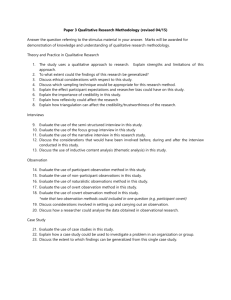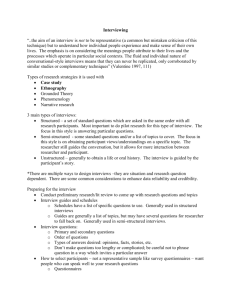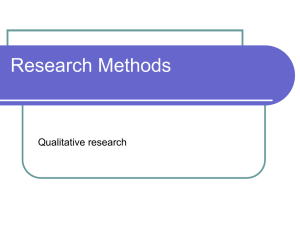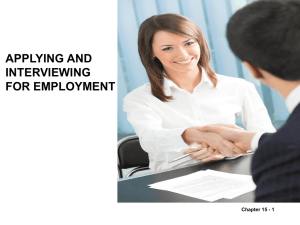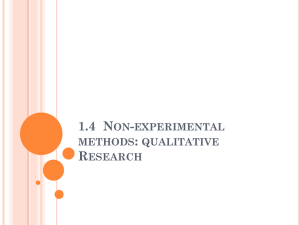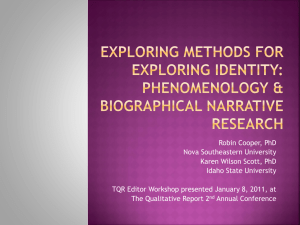Qualitative Research Methods in Education
advertisement
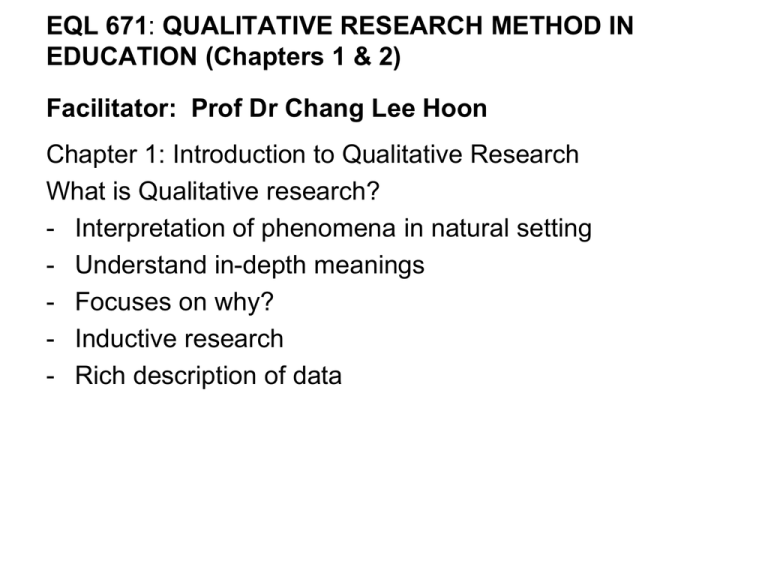
EQL 671: QUALITATIVE RESEARCH METHOD IN EDUCATION (Chapters 1 & 2) Facilitator: Prof Dr Chang Lee Hoon Chapter 1: Introduction to Qualitative Research What is Qualitative research? - Interpretation of phenomena in natural setting - Understand in-depth meanings - Focuses on why? - Inductive research - Rich description of data Differences between Quantitative and Qualitative R 1. 2. 3. 4. 5. 6. 7. 8. 9. 10. Philosophy Goal Focus Method Data collection techniques Research design Sample Generalisation Analysis Role of researcher Qualitative research methods • • • • • • • • Case study Ethnography Phenomenology Historical Action Research Content analysis Grounded theory Generic Checklist on Qualitative research • • • • • • Theoretical approach - Phenomenology in educational research Study design - Sampling Data collection - methods Validity - Researcher as the research instrument - Context biasness - Triangulation Analysis - coding and analysis - reliability & creditability Ethics - human subjects Qualitative Data Collection Techniques • Document examination • Observation • Interviews Kinds of Documents as Data: • Bogdan & Biklen (1998) categorized documents as (a) Personal documents – written by subjects on their actions, experiences and beliefs, private purposes and limited use – diaries – description and reflective commentary of events e.g. record on experience, thoughts, feelings, problems etc – logs – less intimate e.g. daily entry on lesson plans or daily activities – personal letters between friends and family members – reveal relationships, experiences – Autobiographies – available source of data on person’s own story –useful for understanding categories under study e.g. gender, ethnic minorities etc Kinds of Documents as Data: (b) Official documents – produced by organizations for specific purpose - record keeping and dissemination - internal documents – memos, minutes of meetings and others that are circulated inside an organisation usually in hierarchical course – provide info on internal rules & regulations, leadership style, organisational values etc - external communication – produced by organisation for public consumption eg. Newsletters, yearbook, notes to parents, brochures etc – indicators of organisational strategies - Student records and personnel files – achievement records, discipline records, attendance, profiles of family etc – indicators of student’s school career, comments from teachers on the student’s records Kinds of Documents as Data: (c) Popular culture documents – produced for commercial purposes to entertain, persuade & enlighten the public - videos, magazines, TV, films, advertisements – studied as texts (transcripts of shows, lyrics etc) and interpretations of viewers – to make visible “messages” or social constructions in the texts. Personal Documents • Broadly refer to any first person narrative that describes an individual’s actions, experiences and beliefs (Plummer, 1983; Taylor & Bogdan, 1984) • Intimate diaries; for educational researchers, teachers’ diaries that record in detail first teaching experiences, problems with students. • Personal letters (emails?); could reveal the nature of relationships between people, insights of author’s experiences • Autobiographies, including novels Official Documents • Internal documents – Memos or other communications that are circulated inside an organization – Could provide the hierarchical structure, leadership style, potential insight about what organizational members value • External communication – Materials produced for public consumption e.g. letters to parents, curriculum materials etc – Useful in understanding official perspectives on programs, administrative structure • Student Records and Personal Files – Records of all testing, attendance etc Popular Culture Documents • Advertisements • Magazines • Eg. How advertisement of cigarette smoking was constructed as healthy in advertisements (Kellner, 1991); how romance novels for adolescence girls constructed femininity (Christian Smith, 1988) Why documents? • As sole data source (e. g. text and discourse analysis) • As supplement or in support to other data source – interviews and observations Guidelines on documents • Keep a record of documents required and received • Guideline on Document Summary - Ref no: – – – – – – Site: Date received: Type and name of document: How was the document obtained Document’s summary of content Importance of document to study Observation (1) Non-participant/Passive observation - Keep your distance - Unobstrusive - Outsider observation/etic - Phases of non-participant observation (Adler & Adler, 1998; Denzin, 1989, Spradley (1980): - Selection of a setting (where and when) - Definition of what is to be documented in observation and in every case - Training of observers for standardisation in observation - Descriptive observations – initial, general presentation of the field - Focused observation – on aspects relevant to research Q - Selective observation – to purposively grasp central aspects - The end of observation – when theoretical saturation is reached (2) Participant Observation • • • • Participates in activities Insider/emic perspective Active to stimulate discussion Phases of participant observation (Spradley, 1980) - descriptive observation – provides orientation to field under study, non-specific descriptions to grasp complexity of the field and develop more concrete research questions - focused observation – narrows perspectives on processes and problems most essential for research questions - selective observation – towards end of data collection and focused on finding further evidence and e.g. for the types of practices and processes found in step 2. (3) Active Observation • Participation is allowed but limited • Can intrude in activities but researcher remains passive. Process of Observing (Creswell, 2005) • Select a site to be observed that can help you best understand the central phenomenon – obtain required permission to gain access • Ease into the site slowly by looking around, getting a general sense of site, taking limited notes initially • At the site, identify who, what, when, how long to observe • Determine your role • Conduct multiple observation over time • Design some means of recording notes during observation – protocol/fieldnotes Example of Observation Protocol • • • • • • • Event/Activity of observation: Site/Address: Observer Role of observer Date and time of observation Length of observation Place of observation Guideline Descripton of • physical environment • social enviromment • participants Desciption of activites conducted - types of learning activities - teacher’s teaching style - use of materials - students’ responses Description of social interactions T–P P–T P-P Obsevational notes Researcher’s reflective notes Repetitive event/ activity/issue Emerging idea/issue/theme Unique event/ activity/issue Interviews Three types • Structured interviews • Semi-structured interviews • Unstructured interviews Three types of probe questions • Detailed oriented “What happened after you found out that your friend cheated? • Elaboration e.g “Can you tell me more” • Clarification e.g “Did you talk to your teacher? Conducting Interviews (Creswell, 2005) • • • • • • • • • Identify the interviewees Determine type of interview you will use During interview, audiotape the questions and responses Take brief notes during interviews Locate a quite and suitable place for conducting interview Obtain informed consent from interviewee to participate in study Have a plan, but be flexible Use probes to obtain additional information Be courteous and professional when interview is over Example of interview protocol Name of project: Time of interview: Date: Place: Time: Interviewer: Interviewee: Duration of interview: Guideline Establishing Rapport: Desribe the project, tell interviewee of purpose of study, sources of data being collected, how long the interview will take, read and sign the consent form. Probe Questions • detailed-oriented • elaboration •Clarification Closure Thank interviewee, assure confidentiality and potential for future interview (if required) Researcher’s notes Researcher’s reflective notes Triangulation of methods • - 3 types Methods triangulation Investigator triangulation Theory triangulation Sampling • Gaining access • Selecting samples - convenience/availability, -representativeness/critical/typical case • Sampling techniques - purposive - quota - snowballing Skills required of Qualitative Researcher • • • • • Impartiality Tolerance for ambiguity Sensitive Detect personal biases Good communicator, including writing skills Length of time spent in collecting data • Span of time • Degree of contact • refer to other studies Validity of Qualitative Research method 3 types - Descriptive validity - Interpretative validity - Theoretical validity External validity Internal validity
